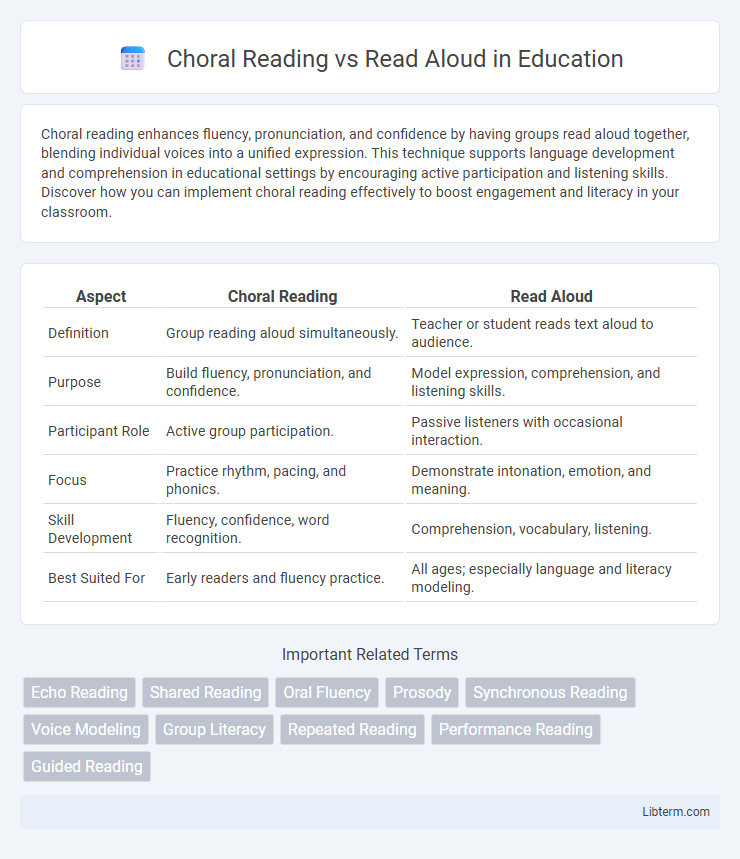Choral reading enhances fluency, pronunciation, and confidence by having groups read aloud together, blending individual voices into a unified expression. This technique supports language development and comprehension in educational settings by encouraging active participation and listening skills. Discover how you can implement choral reading effectively to boost engagement and literacy in your classroom.
Table of Comparison
| Aspect | Choral Reading | Read Aloud |
|---|---|---|
| Definition | Group reading aloud simultaneously. | Teacher or student reads text aloud to audience. |
| Purpose | Build fluency, pronunciation, and confidence. | Model expression, comprehension, and listening skills. |
| Participant Role | Active group participation. | Passive listeners with occasional interaction. |
| Focus | Practice rhythm, pacing, and phonics. | Demonstrate intonation, emotion, and meaning. |
| Skill Development | Fluency, confidence, word recognition. | Comprehension, vocabulary, listening. |
| Best Suited For | Early readers and fluency practice. | All ages; especially language and literacy modeling. |
Introduction to Choral Reading and Read Aloud
Choral reading involves a group of readers speaking a text together in unison, enhancing fluency and expression through collective participation. Read aloud features a single reader conveying a text orally to an audience, emphasizing comprehension and intonation. Both strategies support literacy development but target different aspects of reading skills and classroom engagement.
Defining Choral Reading
Choral reading involves a group of readers speaking a text aloud simultaneously, enhancing fluency and confidence through synchronized vocal practice. Unlike read-aloud sessions where a single reader models pronunciation and intonation, choral reading encourages active participation and reinforces word recognition among learners. This method is particularly effective in classrooms for building foundational literacy skills and engaging students in collaborative learning.
What is Read Aloud?
Read Aloud is an instructional strategy where a teacher or proficient reader vocalizes a text to an audience, emphasizing pronunciation, intonation, and expression to model fluent reading. This method supports comprehension and engagement by allowing listeners to hear fluent reading patterns and understand the material through auditory learning. Unlike Choral Reading, which involves group participation in reading aloud simultaneously, Read Aloud focuses on the single reader's expressive interpretation to enhance listening skills and vocabulary development.
Key Differences Between Choral Reading and Read Aloud
Choral reading involves a group of readers reciting text in unison, promoting fluency and confidence, while read aloud features one person reading aloud to an audience, emphasizing comprehension and engagement. Choral reading encourages synchronized vocal practice and active participation, whereas read aloud allows for expressive intonation and modeling of fluent reading by a skilled reader. The primary difference lies in choral reading's group interaction versus the individualized focus of read aloud sessions.
Benefits of Choral Reading
Choral reading improves fluency by allowing multiple students to read simultaneously, which builds confidence and reduces anxiety associated with solo reading. It enhances pronunciation and rhythm through repetitive practice, fostering better comprehension and engagement with the text. Group reading also promotes collaboration and peer learning, reinforcing social skills alongside literacy development.
Advantages of Read Aloud Practices
Read aloud practices enhance students' listening skills and comprehension by modeling fluent reading and expressive intonation. This method supports vocabulary development and helps learners internalize sentence structure and pronunciation through auditory exposure. Evidence shows that read aloud sessions increase student engagement and build a strong foundation for independent reading proficiency.
Classroom Applications: Choral Reading Strategies
Choral reading strategies in classroom applications enhance fluency and build confidence by having students read texts aloud simultaneously, promoting group cohesion and phonemic awareness. Teachers select repetitive, rhythmic, or predictably patterned texts to encourage participation and improve pronunciation through synchronized reading. Incorporating choral reading supports differentiated instruction by allowing diverse learners to engage collaboratively, reinforcing comprehension and oral language skills.
Effective Read Aloud Techniques
Effective read aloud techniques enhance comprehension and engagement by using expressive voice modulation, clear articulation, and appropriate pacing to bring the text to life. Choral reading complements these strategies by promoting group participation, reinforcing fluency, and building confidence through synchronized oral reading. Combining both methods supports vocabulary development and improves listening skills in diverse learning environments.
Choosing the Right Method for Your Students
Choral reading fosters fluency and confidence by engaging entire groups in unison, making it ideal for developing collective rhythm and pronunciation skills. Read aloud emphasizes expressive intonation and comprehension, which supports individual listening and critical thinking abilities. Selecting the right method depends on your students' proficiency levels and learning objectives, with choral reading benefiting emerging readers and read aloud supporting advanced vocabulary and narration skills.
Conclusion: Integrating Both Approaches for Literacy Success
Integrating choral reading and read aloud techniques enhances literacy development by combining collective engagement with individual comprehension. Choral reading fosters fluency and confidence through shared vocal practice, while read aloud supports critical thinking and listening skills via expressive storytelling. Together, these complementary methods create a balanced, effective approach to improving reading proficiency and fostering a lifelong love for literacy.
Choral Reading Infographic

 libterm.com
libterm.com